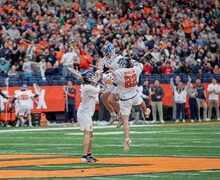Maxwell lecture covers impact of occupation on Palestinian sacred sites
Stella Bellman | Contributing Photographer
Dr. David “Sandy” Marshall speaks to a crowd of around 25 students in Syracuse University's Hall of Languages. His research entailed interviewing a multi-generational group of Palestinians to evaluate the oral traditions of religious sites.
Get the latest Syracuse news delivered right to your inbox.
Subscribe to our newsletter here.
Syracuse University’s Maxwell School of Citizenship and Civic Engagement hosted Dr. David “Sandy” Marshall, an assistant professor at Elon University, for a lecture about the impact of Israel’s historic occupation on Palestinian sacred sites Wednesday afternoon.
During the lecture, titled “Shrines Under Siege: (De)Colonizing Sacred Spaces and Temporalities in Occupied Palestine,” Marshall shared insights from research he conducted in Gaza from 2018-2019. His research entailed interviewing a multi-generational group of Palestinians to evaluate the oral traditions of religious sites both inside and outside of Israeli-held land.
Marshall conducted his research nearly five years before the current Israel-Hamas war began, but said its relevance has grown with the destruction caused by the conflict. One month after the Oct. 7, 2023 Hamas attacks, the non-profit organization Heritage for Peace estimated that over 100 historical landmarks in Gaza had been destroyed.
“With all this unprecedented damage, destruction and death … I would forgive you all for asking me, ‘Why should we care about some dusty old shrines in the West Bank?’” Marshall said. “It’s worth remembering that Article 53 of the Geneva Convention … does protect cultural and spiritual heritage sites, and it considers their damage or destruction a war crime.”
In late January, the BBC reported that at least half of the mosques in the region were damaged or destroyed during the war. A Monday report from The New York Times found that, as of the one-year anniversary of the war’s start, 60% of all buildings on the Gaza Strip were similarly damaged or destroyed.
Marshall said his research involved interviews with more than 60 Muslim Palestinians from three generations: those born around the 1948 Arab-Israeli War; those born around the 1967 Six-Day War; and those born during the era of the Oslo Accords.
He also interviewed eight Christian and Samaritan Palestinians, as well as three Jewish Israelis.
Many shared sacred sites formerly in Palestine are now part of Israel, whose government controls access to these areas, Marshall said. Some religious monuments have cross-cultural significance between Israelis, who are predominantly Jewish, and Palestinians, who are predominantly Muslim.
“Palestinians don’t have the resources or the authority to protect, preserve or narrate their own cultural history,” Marshall said.
Marshall said Palestinians have faced a “cultural genocide” and have consequently relied on oral storytelling to preserve the memory of inaccessible sacred spaces, he said. Throughout the lecture, Marshall recited excerpts from his interviews, emphasizing common themes in Palestinian oral tradition.
Marshall said the people he interviewed, particularly from older generations, often described the natural surroundings of holy sites. Some shared religious stories, and others spoke of “severe restrictions” preventing them from accessing religious sites, Marshall said.
Marshall concluded Palestinians’ association with their historical land is rooted in memories of the physical landscape and the religious folk tradition. He said the stories keep the memory of these places alive despite limited physical mobility.
One attendee, freshman Priyanka Anoop, said she came to the lecture because of a requirement in her CAS 100: Religion, Science and Politics class. She attended with her two classmates, Brianna Barragan and Danielle Veihmeyer.
All three said they found it interesting to hear perspectives from intergenerational Palestinians. Anoop said she believed the event was important to have at SU, especially due to the institution’s religious diversity.
“I like how he interviewed people and it wasn’t just sources from a scholarly journal or database,” Barragan said. “Putting human perspectives and on (these) shrines under siege really makes people connect with the situation.”
Another attendee, Christian Bevilacqua, a master’s student in geography, said he came to the lecture due to his research in geographies throughout the Middle East, specifically Jordan. SU Associate Professor Timur Hammond, who organized the lecture, is one of Bevilacqua’s faculty advisors, he said.
Bevilacqua said the lecture helped him better understand the role oral storytelling can play in preserving culture amid political turmoil. He said research like Marshall’s helps humanize the Israel-Palestine conflict despite its geographical distance.
Echoing Anoop, Bevilacqua also emphasized the importance of Marshall’s presence on a campus with religious diversity. He said that in light of the one-year anniversary of Oct. 7 and the escalation of conflicts in Lebanon and Iran, it’s important for people to continue to seek out personal perspectives of the conflict.
“A general question that we could ask people is, ‘Why don’t we have more of these lectures?’” Bevilacqua said. “How could we get more speakers that really humanize talks that we often polarize within political terms?
Published on October 10, 2024 at 1:06 am
Contact Julia: jmboehni@syr.edu





